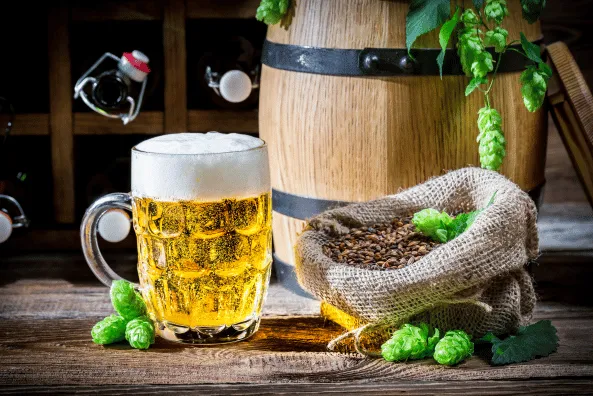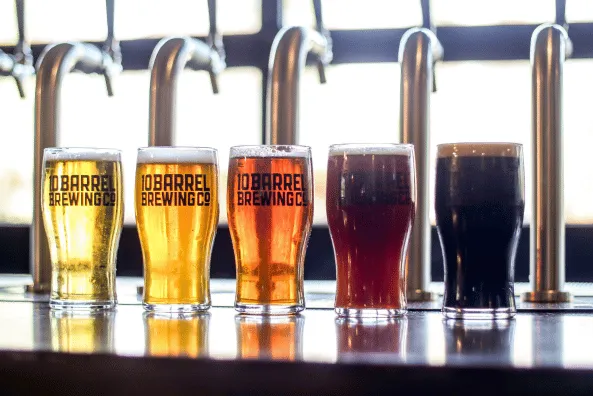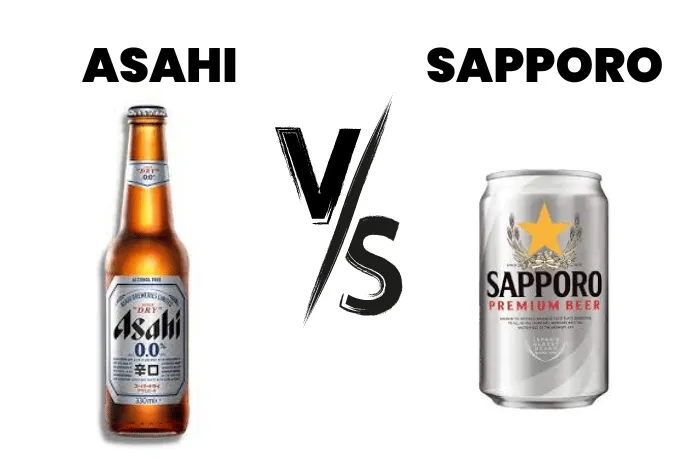If you’re a devotee of Japanese food, then you understand that matching it with the correct beverage can take your eating experience to new heights. To enhance your Japanese dining experience, this blog post will cover the differences between two popular beer brands, Sapporo and Asahi.
First up is Asahi Super Dry, known for its crisp and refreshing taste that perfectly complements sushi and sashimi. We’ll also look closer at Sapporo Premium Beer, another dry-tasting option perfect for cutting through rich flavors in dishes like ramen.
If you want to try something different, we’ve got you covered too! We’ll introduce you to lesser-known Japanese craft beer brands such as Yona Yona Ale and Tokyo Black from Yo-Ho Brewing Company. These flavorful beers are gaining popularity both in Japan and around the world.
Table of Contents:
- Origins and History
- Ingredients
- Fermentation & Brewing Process
- Flavor Profile & Mouthfeel
- Color, Alcohol Content & IBU
- What People are Saying
- FAQs in Relation to Asahi vs Sapporo
- Conclusion
Origins and History
Sapporo and Asahi are two of Japan’s most recognizable beer brands, and their reach has extended far beyond the country’s borders. Both have been brewing for over a century, with Sapporo starting in 1876 and Asahi following shortly after in 1889.
The roots of both firms can be traced to the well-liked German lager beers from that era. Sapporo was founded by Seibei Nakagawa, who studied brewing techniques while living in Germany. In contrast, Asahi was founded by a group of businessmen led by Meiji-era entrepreneur Yasubei Matsui.
Both companies quickly gained popularity due to their unique brewing processes, distinct flavors, and drinkability. Sapporo became so successful that it was selected as one of only four official suppliers for the Tokyo Olympics held in 1964 – an impressive feat considering its relatively young age compared to other breweries around the world at that time.
Asahi’s success story
Asahi’s success story is no less impressive. It’s flagship beer Super Dry has become one of Japan’s most iconic beverages since its launch in 1987 thanks to its light body yet intense flavor profile – something unheard of before then. Asahi’s expansion into the global market was marked by its acquisition of multiple international beer labels, such as Peroni from Italy, Grolsch from the Netherlands, and Pilsner Urquell from the Czech Republic.
The tale of Asahi and Sapporo’s brewing roots stretches back to the late 1800s, with both renowned for their skill in producing top-notch beer. Let’s explore the components that make up these two renowned Japanese lagers – what ingredients are used in their production?
Sapporo vs Asahi: Ingredients, Fermentation, and Brewing Process

Ingredients
Brewing beer can be significantly impacted by the components used in its production. Due to their specific ingredients, Sapporo and Asahi are Japanese beers with unique flavor profiles. For example, both brands use yeast strains, malted barley water, and hops for bittering. But what sets them apart is Sapporo’s use of rice which gives it a distinctive aroma you won’t find in other brews.
Yeast strains are essential in creating flavors and aromas in any beer style. The strain utilized will determine the amount of alcohol produced and provide subtle flavor nuances, such as spicy or fruity notes in the final product. In Sapporo’s case, they use a top-fermenting lager yeast strain called “Sapporo Lager Yeast No1,” which helps create its light and crisp finish with hints of honeydew melon and banana esters on the nose. On the other hand, Asahi uses a bottom-fermenting lager yeast strain known as “Asahi Super Dry Yeast,” which results in a dryer taste with more pronounced hop bitterness than Sapporo has to offer.
Fermentation
Malted barley water, with its capacity to provide both sugars necessary for fermentation and body along with color depending on the degree of roasting it, undergoes during production, is a key component in producing Sapporo and Asahi’s signature maltiness. However, the level of sweetness differs between the two brands; Asahi’s is slightly sweeter due to an extra kilning process conducted by the brewery before brewing that converts enzymes into fermentable sugars (maltose).
Finally, we come to rice which adds a starchy texture and mouthfeel. More importantly, a distinct aroma is associated, especially with the classic version made exclusively in Japan – Hokkaido Brown Rice Ale. This grain provides a delicate nutty note alongside a subtle hint of sweetness thanks to the special koji culture added during the mashing step before boiling takes place, leading up to the creation of the finished product enjoyed by millions of people around the world today.
Brewing Process
Sapporo and Asahi are popular Japanese breweries with distinct brewing processes for their signature beers. As stated, Sapporo uses bottom-fermenting yeasts to create lagers with mild aromas and crisp flavors. In contrast, Asahi utilizes top-fermenting yeasts and less water, producing smoother-tasting lagers.
When crafting unique flavors, both breweries use techniques like dry-hopping or cold filtering during brewing to give each drink its unique character. Dry hopping involves adding hops after primary fermentation, which gives the finished product a more potent hop aroma without imparting too much bitterness to the taste buds.
Cold filtering helps produce more precise beers by removing proteins from the brew before bottling or kegging it. This technique also helps reduce diacetyl levels for better-tasting drinks overall.
Finally, these two breweries employ different aging methods depending on what type of beer they’re making; some may require months, while others can be ready within days or weeks due to their shorter maturation times.
For instance, Sapporo’s Yebisu Black Label Lager undergoes extended lagering (cold storage) for up to three months at temperatures below freezing point before being bottled. In contrast, Asahi’s Super Dry only needs about ten days at room temperature until it’s ready for consumption.
Sapporo vs Asahi: Flavor Profile and Mouthfeel

Flavor Profile
When selecting a brew, taste, and texture are two essential components. Sapporo Premium and Asahi Super Dry both offer unique profiles that appeal to different types of beer drinkers.
Mouthfeel
Sapporo Premium is a light-bodied lager with delicate maltiness, bitterness, and an herbal hop aroma. Its color ranges from golden yellow (2 SRM) to amber orange (4 SRM). Beer enthusiasts describe this brew as having notes of bread dough, grassy hops, lemon zest, and even hints of honey in the aftertaste.
Asahi Super Dry, on the other hand, offers intense dryness. This Japanese-style pilsner features bright golden hues (2 SRM) and an assertive bitter bite at 30 IBU—perfect for those who enjoy hoppier beers. Many descriptions use phrases like “cracker-like maltiness” and “citrusy hop aromas,” Some people even detect a faint herbal aftertaste of basil or thyme.
Sapporo Premium and Asahi Super Dry have distinct flavor profiles that satisfy different palates depending on preference. However, no matter what you choose, you can expect quality craftsmanship backed by centuries-old brewing traditions.
Sapporo vs Asahi: Color, Alcohol Content & IBU
Regarding Sapporo and Asahi beers, color, alcohol content, and IBU can vary greatly. Sapporo is light golden with 4.9% ABV and 18–25 IBU. Asahi, with an ABV of 5-6% and an IBU of 15-20, has a deeper amber color that ranges from pale yellow to dark brown, depending on the variety.
The difference in these parameters helps determine each beer’s flavor profile. For example, Sapporo, with its lower ABV and higher IBU range, has a crisp, slightly bitter taste that goes well with sushi and other seafood. Asahi’s higher ABV and lower IBU make it smoother and better for grilling or spicy foods.
Both beers use natural ingredients like rice malt syrup instead of artificial sweeteners or additives, which contributes to their unique flavors and makes them gluten-free and friendly. In addition, both brands use traditional Japanese brewing methods such as koji fermentation, which adds complexity without sacrificing drinkability.
Regarding color, alcohol content, and IBU, Asahi and Sapporo have distinct differences that should be considered when choosing a beer. Let’s now examine what people are saying about Asahi and Sapporo.
What People Are Saying About Sapporo and Asahi
When comparing Sapporo and Asahi beers, people have plenty of opinions. Generally speaking, the two brands are known for their distinct flavor profiles – Sapporo is often described as crisp and light-bodied, while Asahi is considered more smooth and malty.
Many drinkers say Sapporo has a sweet aroma while Asahi is bitter. Sapporo’s rice malt and Asahi’s barley malt cause this aroma difference.
Lastly, some common criticisms among craft beer lovers include both beers needing more hoppiness or complexity when compared with other popular styles like IPAs or stouts, so it is essential to keep this in mind before making your selection.
FAQs in Relation to Asahi vs Sapporo
What is the difference between Sapporo and Asahi?
Sapporo is a light, crisp lager with a subtle sweetness that pairs well with food. It has an ABV of 5%. Asahi, with more hops than Sapporo, is darker and bitterer. Its alcohol content by volume (ABV) is also higher at 5.5%. Sapporo emphasizes a balance between maltiness and hops, while Asahi emphasizes a dryer taste with stronger hoppy notes.
What makes Asahi different?
Asahi stands out from other beers due to its unique brewing process. Asahi’s flash-brewing method preserves the beer’s flavor and aroma, making it smooth and flavorless. The result is a crisp and clean lager that has become one of Japan’s most popular beers. Asahi also offers seasonal “shibori” (unfiltered) brews and specialty craft ales made with local ingredients like yuzu fruit, distinguishing it from other brands.
What is the number 1 beer in Japan?
The number one beer in Japan is Asahi Super Dry. Since 1987, Japan’s most popular beer has been Asahi Super Dry, a dry beer that pairs well with many dishes. It’s brewed with specially selected malts and hops for a dry flavor that pairs well with many words. Asahi Super Dry has won numerous awards, including gold medals at the World Beer Cup and European Beer Star Awards. Its popularity continues to grow as more people discover its unique taste.
What makes Asahi so good?
Asahi beer is a well-known beverage in Japan, renowned for its crisp and revitalizing flavor. It is light golden with subtle floral notes balanced by a slight bitterness from the hops used in brewing. Asahi also uses high-quality malt and rice to create a smoother flavor profile. Combining these elements makes it an ideal beer for any occasion – perfect for casual drinking or more formal events.
Conclusion
In conclusion, Asahi and Sapporo are two popular Japanese beers with distinct differences. While both have a long history of brewing excellence, their ingredients, fermentation processes, flavor profiles, and more differ. Ultimately, the choice between them is up to personal preference; some may prefer the crispness of Asahi, while others might enjoy the maltiness of Sapporo. Regardless of your opinion on Asahi vs. Sapporo, though, it’s hard to deny that these two beers offer an enjoyable drinking experience for all beer lovers.
Discover the best brews with Brew Publik! Compare Asahi and Sapporo beers to find your perfect pint. Join us today for reviews, equipment advice, subscription services, and more!
Also Visit: Exploring the Differences Between Lager and Porter Beers
